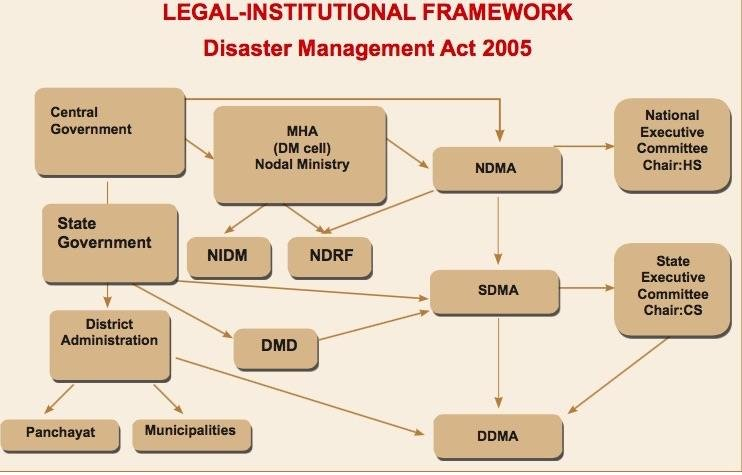-
14 Aug 2024
GS Paper 3
Disaster Management
Day 33: Discuss the framework related to Disaster Management in India. (150 words)
Approach
- Briefly describe the need for Disaster Management Framework in India.
- Discuss the framework related to Disaster Management in India.
- Conclude Suitably.
Introduction
India is vulnerable, in varying degrees, to a large number of natural as well as man-made disasters. 58.6 percent of the landmass is prone to earthquakes of moderate to very high intensity; over 40 million hectares (12 per cent of land) is prone to floods and river erosion; of the 7,516 km long coastline, close to 5,700 km is prone to cyclones and tsunamis; 68 per cent of the cultivable area is vulnerable to drought and hilly areas are at risk from landslides and avalanches.This necessitates the establishment of a robust disaster management framework in the country.
Body
Framework Related to Disaster Management in India
- Disaster Management Act of 2005: The Disaster Management Act of 2005 has provided the legal and institutional framework for disaster management in India at national, state and district levels.
- While the primary responsibility of disaster management rests with the States, the Central Government supports the efforts of State Governments by providing logistical and financial support.
- Institutional Framework under Disaster Management Act of 2005 :
- National Disaster Management Authority (NDMA): Apex body headed by the Prime Minister, responsible for policy, plan, and guideline formulation for disaster management (DM).
- NDMA addresses both natural and man-made disasters and coordinates enforcement and implementation.
- National Executive Committee (NEC): Assists NDMA, chaired by the Union Home Secretary, comprising various secretaries and officials.
- Prepares and monitors the National Plan for DM and coordinates responses to disaster situations.
- State Disaster Management Authority (SDMA): Headed by the Chief Minister, responsible for state-level DM policies and plans, coordinating implementation, and integrating mitigation measures in state development plans.
- District Disaster Management Authority (DDMA): Led by the District Collector with an elected representative as Co-Chairperson.
- Prepares and implements district-level DM plans and ensures compliance with national and state policies.
- Local Authorities: Includes Panchayati Raj Institutions, Municipalities, District and Cantonment Boards, and Town Planning Authorities. Responsible for capacity building, relief, rehabilitation, and preparing DM plans.
- National Disaster Management Authority (NDMA): Apex body headed by the Prime Minister, responsible for policy, plan, and guideline formulation for disaster management (DM).
- Key Institutions:
- National Institute of Disaster Management (NIDM): Focuses on capacity development, training, research, and documentation.
- Functions under NDMA’s guidelines and aims to become a ‘Centre of Excellence’ in DM.
- National Disaster Response Force (NDRF): Specialized response force for natural and man-made disasters, including Chemical, Biological, Radiological, and Nuclear emergencies.
- Operates under NDMA's direction, with eight battalions positioned across different locations.
- National Institute of Disaster Management (NIDM): Focuses on capacity development, training, research, and documentation.
- Committees:
- Cabinet Committee on Management of Natural Calamities (CCMNC): Oversees management of natural calamities, suggests preventive measures, and promotes public awareness.
- International Commitments:
- Sendai Framework for Disaster Risk Reduction (SFDRR): India is a signatory to the SFDRR which was adopted during the Third UN World Conference on Disaster Risk Reduction in March 2015.
- India is dedicated to achieving the seven goals set under the framework through systematic and sustainable efforts.
- Hyogo Framework for Action (HFA): India is a signatory to the HFA, adopted globally to reduce disaster losses in lives and economic and environmental assets.
- The HFA set three strategic goals and five priority action areas focused on integrating disaster risk reduction into sustainable development policies, capacity building, preparedness, and vulnerability reduction.
- Sendai Framework for Disaster Risk Reduction (SFDRR): India is a signatory to the SFDRR which was adopted during the Third UN World Conference on Disaster Risk Reduction in March 2015.
Conclusion
India's disaster management framework is comprehensive, covering all aspects from preparedness to recovery. However, to ensure a more effective and resilient system, there is a need to strengthen institutions, enhance capacity, and promote technological innovation. By addressing these challenges, India can better mitigate the risks of disasters and build a more resilient nation. The continuous evolution of policies and practices will be key to achieving sustainable disaster management in the country.





